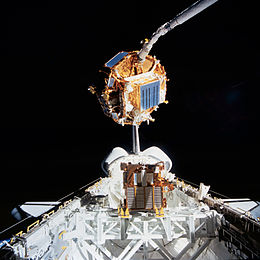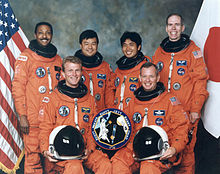STS-72

Endeavour captures the Space Flyer Unit
|
|||||
| Mission type | Satellite retrieval Research |
||||
|---|---|---|---|---|---|
| Operator | NASA | ||||
| COSPAR ID | 1996-001A | ||||
| SATCAT № | 23762 | ||||
| Mission duration | 8 days, 22 hours, 01 minutes, 47 seconds | ||||
| Distance travelled | 6,000,000 kilometres (3,700,000 mi) | ||||
| Orbits completed | 142 | ||||
| Spacecraft properties | |||||
| Spacecraft | Space Shuttle Endeavour | ||||
| Launch mass | 112,182 kilograms (247,319 lb) | ||||
| Landing mass | 98,549 kilograms (217,263 lb) | ||||
| Payload mass | 6,510 kilograms (14,350 lb) | ||||
| Crew | |||||
| Crew size | 6 | ||||
| Members |
Brian Duffy Brent W. Jett Leroy Chiao Winston E. Scott Koichi Wakata Daniel T. Barry |
||||
| Start of mission | |||||
| Launch date | 11 January 1996, 09:41:00.072 UTC | ||||
| Launch site | Kennedy LC-39B | ||||
| End of mission | |||||
| Landing date | 20 January 1996, 07:41:41 UTC | ||||
| Landing site | Kennedy SLF Runway 15 | ||||
| Orbital parameters | |||||
| Reference system | Geocentric | ||||
| Regime | Low Earth | ||||
| Perigee | 185 kilometres (115 mi) | ||||
| Apogee | 470 kilometres (290 mi) | ||||
| Inclination | 28.45 degrees | ||||
| Period | 91.1 min | ||||
|
|
|||||


Left to right - Seated: Jett, Duffy; Standing: Scott, Chiao, Wakata, Barry
STS-72 was a Space Shuttle Endeavour mission to capture and return to Earth a Japanese microgravity research spacecraft known as Space Flyer Unit (SFU). The mission launched from Kennedy Space Center, Florida on 11 January 1996.
STS-72, the 74th flight of the Space Shuttle program and the 10th of the orbiter Endeavour was launched at 4:41AM EST January 11, 1996 after a brief hold at the T-5 minute mark due to communication issues. The nighttime launch window was in support of the mission's primary objective, the capture and return to Earth of a Japanese microgravity research spacecraft known as Space Flyer Unit (SFU). The 3,577 kilograms (7,886 lb) SFU was launched by Japan's National Space Development Agency (NASDA) from Tanegashima Space Center in Japan on 18 March 1995 aboard a Japanese H-II rocket (HII-3), and spent ten months in orbit conducting automated research in materials science, biology, engineering, and astronomy. Mission Specialist Koichi Wakata operated the orbiter's remote manipulator system arm on flight day three to pluck SFU from orbit. Both of the satellites's solar arrays had to be jettisoned prior to retrieval when sensors indicated improper latching following their retraction. This jettison procedure had been incorporated in preflight training as a contingency in the event of such an occurrence. The canisters housing the arrays were jettisoned 12 minutes apart as Endeavour and the SFU traveled across Africa on the thirtieth orbit of the mission. The contingency procedure delayed the capture of the satellite by about an hour and half. Once in Endeavour's payload bay, the satellite's internal batteries were bypassed following connection of a remotely operated electrical cable to the side of the satellite.
...
Wikipedia
